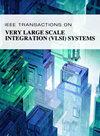针对基于雷达的手势识别,采用无乘法折叠累积 PE 的高能效神经网络加速器的软硬件协同设计
IF 2.8
2区 工程技术
Q2 COMPUTER SCIENCE, HARDWARE & ARCHITECTURE
IEEE Transactions on Very Large Scale Integration (VLSI) Systems
Pub Date : 2024-06-17
DOI:10.1109/TVLSI.2024.3409674
引用次数: 0
摘要
本研究提出了一种新型轻量级神经网络(NN)模型和专用 NN 加速器,用于基于雷达的手势识别(HGR)。该神经网络模型采用了对称权重、组一维卷积和二乘幂(POT)量化技术,在仅有 4.8 k 个参数的公共数据集上实现了 92.84% 的准确率,同时将参数存储量减少了 40%。定制加速器具有无乘法折叠累积处理元件(PE)、分组计算优化和全连接(FC)层的高效调度机制。它采用赛灵思现场可编程门阵列(FPGA)板 XC7S15 和 65 纳米 CMOS 技术实现,在能效和成本效益方面超越了现有解决方案,满足了物联网部署的计算需求。本文章由计算机程序翻译,如有差异,请以英文原文为准。
A Hardware and Software Co-Design for Energy-Efficient Neural Network Accelerator With Multiplication-Less Folded-Accumulative PE for Radar-Based Hand Gesture Recognition
This work presents a novel lightweight neural network (NN) model and a dedicated NN accelerator for radar-based hand gesture recognition (HGR). The NN model employs symmetric weights, group 1-D-convolution, and power-of-two (POT) quantization, achieving 92.84% accuracy on a public dataset with only 4.8 k parameters, while reducing parameter storage by 40%. The custom accelerator features a multiplication-less folded-accumulative processing element (PE), group-wise computation optimization, and an efficient scheduling mechanism for fully connected (FC) layers. Implemented on a Xilinx field-programmable gate array (FPGA) board XC7S15 and 65-nm CMOS technology, it surpasses existing solutions in power efficiency and cost-effectiveness, addressing the computational demands for IoT deployment.
求助全文
通过发布文献求助,成功后即可免费获取论文全文。
去求助
来源期刊
CiteScore
6.40
自引率
7.10%
发文量
187
审稿时长
3.6 months
期刊介绍:
The IEEE Transactions on VLSI Systems is published as a monthly journal under the co-sponsorship of the IEEE Circuits and Systems Society, the IEEE Computer Society, and the IEEE Solid-State Circuits Society.
Design and realization of microelectronic systems using VLSI/ULSI technologies require close collaboration among scientists and engineers in the fields of systems architecture, logic and circuit design, chips and wafer fabrication, packaging, testing and systems applications. Generation of specifications, design and verification must be performed at all abstraction levels, including the system, register-transfer, logic, circuit, transistor and process levels.
To address this critical area through a common forum, the IEEE Transactions on VLSI Systems have been founded. The editorial board, consisting of international experts, invites original papers which emphasize and merit the novel systems integration aspects of microelectronic systems including interactions among systems design and partitioning, logic and memory design, digital and analog circuit design, layout synthesis, CAD tools, chips and wafer fabrication, testing and packaging, and systems level qualification. Thus, the coverage of these Transactions will focus on VLSI/ULSI microelectronic systems integration.

 求助内容:
求助内容: 应助结果提醒方式:
应助结果提醒方式:


